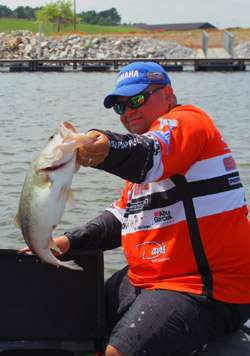
Elite Series pro Bill Lowen is well-known on the circuit for his shallow water bass catching tactics. Often, when the other guys are out in the middle of the lake fishing deep ledges and channels, you'll find Lowen in the backs of creeks and bays fishing water that's only a few inches deep.
Here are 8 tips from the North Bend, Ohio, resident that'll help you take advantage of the shad and bass migration into the shallows this fall.
1. Think shallow.
"Fishing creeks in the fall is a shallow water exercise. Most times I'm fishing in a foot or two of water near a channel that's maybe 3 feet deep. You want to fish the flats in the back of the creeks, but stay as close to the channel or a drop as possible.
"A small drop — 6 inches — looks like a lot in a couple of feet of water. Bass don't need much to find a suitable ambush point. I take my boat up into the creek until it gets stuck — with the trolling motor up! Then I throw my baits as far as possible into ankle deep water. You'd be surprised at how many good ones you'll catch doing that."
2. Look for wood.
"I always look for wood — a stump, laydown or tree limb is perfect. The best wood is almost always located near the channel or deeper water. Deep water is important. The bass always need a way in and out."
3. Pick the right bait.
"Small, handmade flat sided balsa crankbaits are best for this type of bass fishing. They have an extraordinary action, run shallow, float high in the water column and are as snag resistant as a crankbait can be. Lazer Lures and Wee Baits are my favorites. (Both are handmade in Ohio.)
"If the water is too shallow for a crankbait, throw a buzzbait or a spinnerbait. Do this only if you have no other choice, however. Small balsa crankbaits are the best.
4. Don't worry about matching the hatch.
"I don't pay much attention to baitfish size at this time of year. Larger baits are generally more effective with larger bass in the fall. I think that's because the baitfish have had all year to grow, but I really don't know for sure. I do know, however, that big fall bass like big baits.
"And I follow the same theory with color. I don't spend a lot of time trying to match my bait color to the local shad. Basic combinations — black, blue or green back with silver or gold sides — are about all I ever throw."
5. Rig two rods and reels.
"To catch shallow water bass back in the creeks you'll need two outfits. I use a 7 1/2-foot All Pro cranking rod for both. On one I mount a Revo STX (high speed) reel. On the other mount a lower gear ratio Revo.
"Some days they want it fast, bouncing and careening off everything in sight. But on other days they want it crawling through the wood. You never know so it's best to be prepared with two identical outfits except for the gear ratio of your reel."
6. Your line matters.
"Small, handmade balsa crankbaits are designed to run properly with monofilament line. I prefer Berkley Big Game in 12-pound-test. I know fluorocarbon line is all the rage now. It's tempting to use it. But it doesn't stretch, and balsa baits need stretch to run right and catch bass."
7. Cast repeatedly to the same target.
"If you haven't thrown at least eight times — 12 is better — to the same target, you haven't fished it properly. Bring your bait over every angle and every spot from every direction. It's amazing how many fish you can catch doing this. They may ignore your lure until it's at the precise angle that lets them ambush it. Your job is to find that angle and spot. You can't do that with one cast."
8. Be quiet, but don't let the fear of making noise consume you.
"I try to be quiet when I'm fishing skinny water. You can spook the bass with too much noise. But don't let noise play head games with you. I know guys who spend more time being quiet than they do fishing. That's ridiculous. Use common sense and keep fishing. You'll catch 'em."
Originally published September 2008




